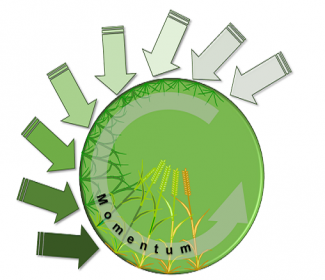Across eight sites in one season, only two tests of momentum treatments were significant
The idea of crop momentum arose because high yields in the YEN associated with little-and-often applications, or ‘attention to detail’. Also, two interacting factors are thought to drive crop growth: assimilate supply (source), and assimilate storage capacity (sink). It was suggested that the initial source may affect the sink at the next stage; so increasing initial growth may enhance subsequent growth, creating ‘momentum’.

So in 2019 the Momentum FIG tried to alleviate stresses at early stages in crop development in order to enhance growth at later stages. Farmers monitored crops through soil, leaf and grain analysis. Then they tested stress-alleviating treatments: biostimulants and foliar sprays (particularly micro-nutrients and phosphites). Each farmer set up a tramline trial in winter wheat. Fields were carefully selected and included replicated treatments. Trial sites covered a wide range of soil types and locations. Eleven trials were set up in autumn 2018 of which eight provided yield data. Two trials showed positive yield responses (+0.62 & +0.93 [RS1] t/ha) whilst at the other sites, despite up to 17 applications of micro-nutrients and biostimulant products, there were no significant responses. The two sites that did respond were high yielding, although on drought-prone sandy soils. These findings, in this season, suggest that most crops had enough resources for maximum growth and did not require these additional applications. From farmer discussions, there was a clear need for more targeted observations to support micronutrient and biostimulant use, and more evidence on the relative merits of the products themselves.
Click here to read full report.
